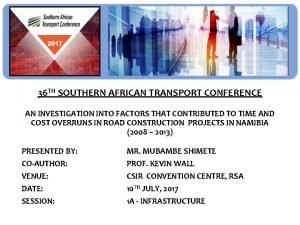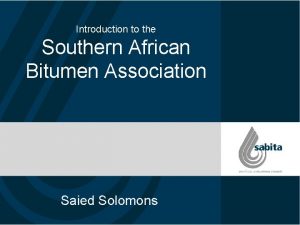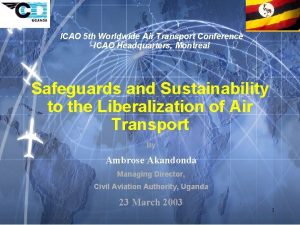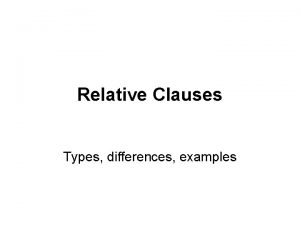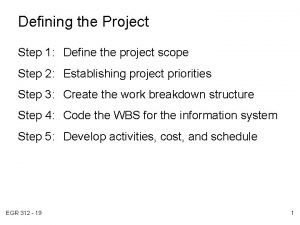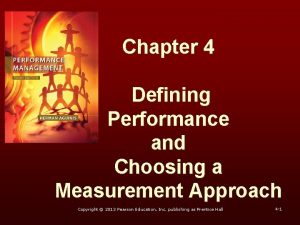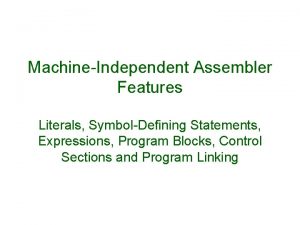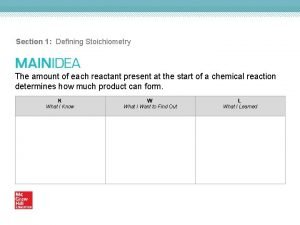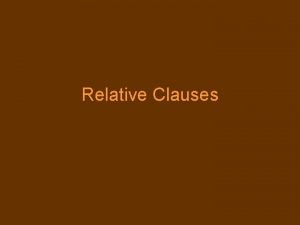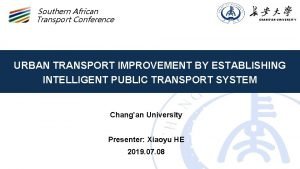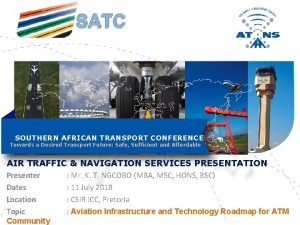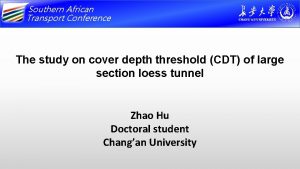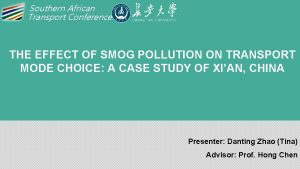38 th Southern African Transport Conference Defining a














































- Slides: 46

38 th Southern African Transport Conference Defining a PBS framework for High Capacity Vehicles (HCVs) in Europe Project FALCON: Freight And Logistics in a multimodal CONtext 9 July 2019 Presenter: Christopher de Saxe Originally presented at HVTT 15, Rotterdam: C de Saxe, K. Kural, S. Kharrazi, F. Schmidt, C. van Geem, R. Berman, J. Woodrooffe, D. Cebon, “FALCON III: Defining a Performance-Based Standards framework for High Capacity Vehicles in Europe, ” 15 th International Heavy Vehicle Transport Technology Symposium, Rotterdam, 2 -5 Oct 2018, pp 135 -147 1

Project team Christopher de Saxe Karel Kural Sogol Kharrazi Franziska Schmidt Carl van Geem Robert Berman John Woodrooffe David Cebon • 2 CSIR, South Africa CSIR, ZA HAN, NL VTI, SE IFSTTAR, FR BRRC, BE CSIR, ZA U. of Michigan, USA U. of Cambridge, UK 2

Introduction • What? • Investigate a Performance-Based Standards (PBS) framework for the regulation of High Capacity Vehicles (HCVs) in a multi-modal European freight transport system • Why? • CO 2 reduction targets of 80% by 2050 (w. r. t. 1990) • High capacity vehicles reduce road freight emissions • PBS has been successful in a number of countries • How? • Define a representative European HCV fleet • Assess against all available PBS standards • Make recommendations on suitability for Europe 3

High Capacity Vehicles (HCVs) 44

High Capacity Vehicles Re d Re uc ed fu Re du el co ce d ro ad ns um pt 5 du io n* Fe we ce we d ar * *Per tonne-km rt em ru ck s iss io ns * on th e ro ad Safe high-speed performance Professional and compliant operators Adequate manoeuvrability for route Well-maintained vehicles Ensure vehicle infrastructure match The best drivers

High Capacity Vehicles Safe vehicle performance Safe vehicle operation Performance-Based Standards (PBS) National Heavy Vehicle Accreditation Scheme (NHVAS) Performance-Based Standards (PBS) Road Transport Management System (RTMS) European Modular System (EMS) HCVs implemented/piloted in many individual states Longer Semi-Trailer (LST) (UK) 6

Performance-Based Standards (PBS) 77

Performance-Based Standards 8 Prescriptive Standards Performance-Based Standards What the vehicle looks like What the vehicle can do Governs mass and dimensions Governs actual on-road performance Constrains productivity Allows heavier and/or larger vehicles Constrains innovation Promotes innovation Images courtesy of the Australian National Transport Commission

Performance-Based Standards: Safety Manoeuvre/Test 9 Performance Standard Low-speed 90° turn (5 km/h) Low-speed swept path Tail swing Frontal swing Steer-tyre friction demand High-speed lane-change (80 km/h) Rearward amplification High-speed transient offtracking Rollover Static rollover threshold High-speed pulse steer (80 km/h) Yaw damping coefficient High-speed on uneven road (90 km/h) Tracking ability on a straight path Various (driveability standards) Startability Gradeability A Gradeability B Acceleration Capability

Performance-Based Standards: Infrastructure Criteria 10 Required performance Road wear impact Must exhibit less road wear impact per tonne-km versus baseline vehicle Bridge loading impact Bending moment and sheer stresses Must meet A/L bridge formula Axle loading May not exceed legal axle loads

FALCON Methodology Existing PBS standards & criteria (Australia, Canada, etc) Existing vehicle & infrastructure policy in Europe Representative European road network library Assess vehicle fleet against all PBS standards Representative vehicle fleet Assess fleet on a representative road network European PBS framework (standards, criteria, methodologies) 11 Road network access classification framework

Representative heavy vehicle fleet 12 12

Representative heavy vehicle fleet 1. 27 vehicle combinations, including: • 96/53/EC-compliant combinations • EMS-type combinations • Long (>30 m) HCVs from EU pilot programmes (i. e. “EMS 2”) 2. Configurations & dimensions • Vehicle parameters selected with industry partners • Combination length: ~ 16 – 36 meters • Combination mass: ~ 30 – 74 tonnes 3. No active control / steering (except LST) • We want to assess passive safety performance 13

Representative fleet: Loading units 45 -foot container 40 -foot container 20 -foot container C 782 swap body 13. 6 m trailer 14 14. 92 m trailer (DE)

Representative fleet: Examples Tractor semi-trailer (conventional) Rigid + pup trailer (conventional) B-double (with LST) “Nordic combination” A-double 15

Performance standards evaluated 16 16

Performance standards: Driveability 17

Performance standards: Manoeuvrability 18

Performance standards: High-speed stability 19

Performance standards: Winter conditions 20

Performance standards: Infrastructure Objectives: • Find the impact of HCVs relative to conventional EU combinations • Define appropriate assessment methodologies for European PBS 21

Simulations overview 22 22

Simulations The simulations helped answer questions such as: • • • 23 How do the HCVs compare to existing EU combinations? Which standards need optimising for Europe? Which standards are redundant? Which vehicle combinations perform poorly? Do we need special winter-specific standards? Is the PBS framework compatible with European routes?

Simulations • Vehicle dynamics • CSIR: Truck. SIM, MATLAB • VTI: MATLAB + Sim. Mechanics • HAN: MATLAB + Sim. Mechanics • Vehicle dynamics (winter) • Vehicle dynamics on road network • Road wear impact • BRRC: Alizé-LCPC • Bridge loading • IFSTTAR: ST 1 24

Payload modelling • EU road freight loading statistics, including: • EU semitrailer loading [EC, 2011] • Average EU volume utilisation [Lumsden, 1998] • Findings: • Average load height = 82% of available loading height • Average payload density = 156 kg/m 3 • Implementation: • • 25 Conservative assumption of uniform density Co. G = 41% loading space height 188 kg/m 3 load density (EU average + 20%) 280 kg/m 3 critical loading density (max axle loads)

Payload modelling H 82%∙H 41%∙H 26

Example results: Load transfer ratio & rearward amplification Representative loading 27 Critical loading Take-aways: 1. Strong correlation between Dynamic Load Transfer Ratio and Rearward Amplification 2. Vehicles 4. 5, 4. 6, & 6. 3 fail outright (centre-axle combinations)

Recommendations Road network classification Performance standards & criteria 28 28

Recommendations: Road network classification Australian PBS road access levels: European PBS proposal: Add “Level 0”: “City access” Stricter manoeuvrability criteria E. g. Garbage trucks, urban delivery “Minor roads” (Existing truck routes) incl. roundabout test ? “Arterial main express roads” (~EMS) “Motorways” (~EMS 2) Level 4 not applicable to Europe (Australian outback, road-trains) 29

Recommendations: Performance Standards Driveability • Australian standards • Relax Startability and Gradeability criteria Manoeuvrability • Australian standards + EU roundabout for Level 0 • Tighten criteria for tail swing & frontal swing • Review Mo. D and Do. M for possible exclusion High speed stability • Rearward Amplification (mod. ) + Load Transfer Ratio • Tracking Ability on a Straight Path redundant • High Speed Steady-State Off-tracking redundant 30

Recommendations: Performance Standards Winter standards • Low friction performance well correlated with high friction • No additional standards required • ABS remains mandatory Infrastructure • No additional bridge loading by HCVs (relative to standard tractor-semi) • Less road wear per m 3 -km by HCVs (relative to standard trucks) • Standard methodologies proposed 31

Other findings 1. Poor performing vehicles • 1+1 full trailer • Centre-axle trailer combinations 2. Some combinations need optimisation • Case study done to demonstrate improvements 3. Support programmes are critical • Self-regulation and accreditation • NHVAS & IAP (Australia) • RTMS (SANS 1395 -1: 2014) (South Africa) 32

Conclusions 1. A PBS framework for Europe has been proposed: • Road access classification • Selected performance standards & modifications • Bridge and road wear methodologies 2. Implementation: • Learnings from Australia, Sweden, South Africa etc • EMS-type framework, Directive 2015/719, or amendments to Directive 96/53/EC? 3. Full report to be published soon: • “D 3. 1/5/6: Definition and Validation of a Smart Infrastructure Access Policy utilising Performance-Based Standards” (https: //www. cedr. eu/home/publications/) 33

Funding CEDR MAN Truck & Bus 34

Thank you. C. de Saxe CSIR Smart Mobility cdsaxe@csir. co. za 35 35

Recommendations: Driveability Review criteria (too stringent) 36

Recommendations: Manoeuvrability Reduce limit to 0. 5 m Review incidents, possibly discard standards Can reduce limit to 0. 3 m for all levels Australian standards best for long combinations Include EU roundabout requirement for L 0 & L 1 37

Recommendations: High-speed stability Use a combination of RA (rear trailer) and LTR Review appropriateness of existing pass criteria Exclude. Highly correlated with HSTO, complex Exclude. Highly correlated with combination length 38

Recommendations: Winter conditions ABS remains mandatory Exclude. Correlated with high friction performance Exclude. Allow temporary axle load proportioning Exclude. Equivalent high-mu performance at 60 km/h 39

Recommendations: Infrastructure 40 • • No any additional impact, compared to standard tractor semi-trailer Two potential methods: 1. Bridge formula based on representative infrastructure, 2. Thresholds on bending moments and shear • • HCVs less damaging per m 3 -km than standard EU combinations Method: 1. Representative road structures 2. Compare aggressiveness to a 40 -tonne tractor-semitrailer 3. HCV performance should be better in m 3 -km

Performance standards: Manoeuvrability Standard EU roundabout Extrapolated for longer vehicles 41

LTR vs. RA Rep. loading Crit. loading 1. Strong correlation between Dynamic Load Transfer Ratio and Rearward Amplification 2. Vehicles 4. 5, 4. 6, & 6. 3 fail outright (centre-axle combinations) 42

HTSO vs TASP Rep. loading 1. 2. 3. 4. 43 Crit. loading Strong correlation between High-Speed Transient Off-tracking and Tracking Ability on a Straight Path The only noticeable outlier is 6. 3, which rolls during the TASP manoeuvre HSTO is the limiting standard for all road access levels TASP therefore does not seem to add much value

HSSO vs. length Rep. loading 1. 2. 3. 44 Crit. loading High Speed Steady-State Off-tracking is highly correlated with combination length. HSSO does not offer much additional information, and is an additional stand-alone manoeuvre to simulate It is preferable to simply use the Australian method of imposing maximum combination lengths per road access level.

Low-speed turning EU/UK roundabout Netherlands turning circle #2 1. All groups 3 -6 vehicles fail UK/EU roundabout (except 4. 6) 2. There is strong correlation between LSSP and NL roundabout 3. This suggests we need only one standard (e. g. Australian LSSP), however the standard EU/UK roundabout should be retained as this is non-negotiable in the UK. 4. The additional NL turning circle tests do not add more value. 45

Performance standards: Manoeuvrability 97/27/EC, UK – Turning circle Aus. PBS – Low-speed swept path More restrictive swept path requirement Tail swing ≤ 0. 8– 1. 2 m Tail swing ≤ 0. 3– 0. 5 m Frontal swing not addressed Frontal swing ≤ 0. 7 m Required in many EU countries Longer vehicles may jackknife 46 Usable test for long & short vehicles
 Southern african transport conference
Southern african transport conference South african transport conference
South african transport conference Relative clauses
Relative clauses Relative clauses defining and non defining
Relative clauses defining and non defining Non essential relative clause
Non essential relative clause Relative clauses defining and non defining
Relative clauses defining and non defining Defining relative clause meaning in telugu
Defining relative clause meaning in telugu Relative clauses defining
Relative clauses defining Southern african bitumen association
Southern african bitumen association Southern california kindergarten conference
Southern california kindergarten conference Southern outlook conference
Southern outlook conference Passive transport vs active transport venn diagram
Passive transport vs active transport venn diagram Active transport diagram
Active transport diagram Unlike passive transport, active transport requires
Unlike passive transport, active transport requires Passive transport vs active transport venn diagram
Passive transport vs active transport venn diagram Bioflix membrane transport
Bioflix membrane transport Primary vs secondary active transport
Primary vs secondary active transport Primary active transport vs secondary active transport
Primary active transport vs secondary active transport Membrane structures that function in active transport
Membrane structures that function in active transport Bioflix activity membrane transport active transport
Bioflix activity membrane transport active transport Air transport conference
Air transport conference Defining stoichiometry
Defining stoichiometry Connective relative clause examples
Connective relative clause examples Professional nursing practice 7th edition
Professional nursing practice 7th edition Defining risk management
Defining risk management Approaches to measuring performance
Approaches to measuring performance Examples of paragraph
Examples of paragraph Defining globalization
Defining globalization Romeo and juliet act 4 summary
Romeo and juliet act 4 summary Human rights definitions
Human rights definitions Defining a project
Defining a project Whats a relative clause
Whats a relative clause Approaches to measuring performance
Approaches to measuring performance Defining moments
Defining moments Symbol defining statements in assembler
Symbol defining statements in assembler Objectives in problem formulation means
Objectives in problem formulation means Defining customer satisfaction
Defining customer satisfaction The defining moment in greek history is the wars
The defining moment in greek history is the wars Defining policy practice in social work
Defining policy practice in social work Defining competitiveness
Defining competitiveness Defining stoichiometry worksheet answers
Defining stoichiometry worksheet answers Defining sentence example
Defining sentence example Components of globalization
Components of globalization Defining marketing for the 21st century
Defining marketing for the 21st century Defining terms geometry
Defining terms geometry Lady montague defining quotes
Lady montague defining quotes Defending and non defining relative clauses
Defending and non defining relative clauses

